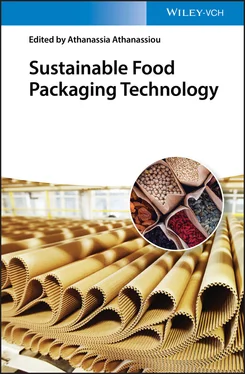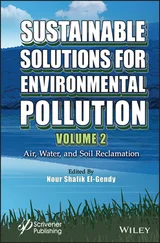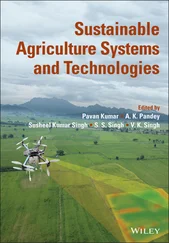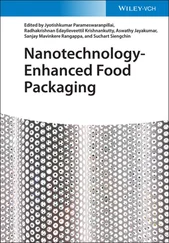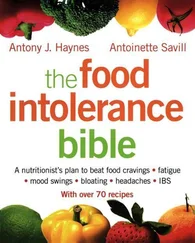1 1 Szczepańska, N., Kudłak, B., and Namieśnik, J. (2018). Recent advances in assessing xenobiotics migrating from packaging material: a review. Analytica Chimica Acta 1023: 1–21.
2 2 Krishna, A., Cian, L., and Aydınoğlu, N.Z. (2017). Sensory aspects of package design. Journal of Retailing 93 (1): 43–54.
3 3 Kim, D. and Seo, J. (2018). A review: breathable films for packaging applications. Trends in Food Science & Technology 76: 15–27.
4 4 Hahladakis, J.N., Velis, C.A., Weber, R. et al. (2018). An overview of chemical additives present in plastics: migration, release, fate and environmental impact during their use, disposal and recycling. Journal of Hazardous Materials 344: 179–199.
5 5 Geueke, B., Groh, K., and Muncke, J. (2018). Food packaging in the circular economy: overview of chemical safety aspects for commonly used materials. Journal of Cleaner Production 193: 491–505.
6 6 Dilkes‐Hoffman, L.S., Lane, J.L., Grant, T. et al. (2018). Environmental impact of biodegradable food packaging when considering food waste. Journal of Cleaner Production 180: 325–334.
7 7 Romani, V.P., Machado, A.V., Olsen, B.D., and Martins, V.G. (2018). Effects of pH modification in proteins from fish (Whitemouth croaker) and their application in food packaging films. Food Hydrocolloids 74: 307–314.
8 8 Kurek, M., Ščetar, M., and Galić, K. (2017). Edible coatings minimize fat uptake in deep fat fried products: a review. Food Hydrocolloids 71: 225–235.
9 9 Otoni, C.G., Avena‐Bustillos, R.J., Olsen, C.W. et al. (2016). Mechanical and water barrier properties of isolated soy protein composite edible films as affected by carvacrol and cinnamaldehyde micro and nanoemulsions. Food Hydrocolloids 57: 72–79.
10 10 Tavassoli‐Kafrani, E., Shekarchizadeh, H., and Masoudpour‐Behabadi, M. (2016). Development of edible films and coatings from alginates and carrageenans. Carbohydrate Polymers 137: 360–374.
11 11 Bertuzzi, M.A. and Slavutsky, A.M. (2016). Standard and new processing techniques used in the preparation of films and coatings at the lab level and scale‐up. In: Edible Films and Coatings (eds. M.P.M. García, M.C. Gómez‐Guillén, M.E. López‐Caballero and G.V. Barbosa‐Cánovas), 21–42. Boca Raton, Florida: CRC Press.
12 12 de la Caba, K., Guerrero, P., Trung, T.S. et al. (2019). From seafood waste to active seafood packaging: an emerging opportunity of the circular economy. Journal of Cleaner Production 208: 86–98.
13 13 Suresh, P.V., Kudre, T.G., and Johny, L.C. (2018). Sustainable valorization of seafood processing by‐product/discard. In: Waste to Wealth (eds. R.R. Singhania, R.A. Agarwal, R.P. Kumar and R.K. Sukumaran), 111–139. Singapore: Springer.
14 14 FAO (2018). The State of World Fisheries and Aquaculture. Food and Agriculture Organization of the United States.
15 15 Kafle, G.K., Kim, S.H., and Sung, K.I. (2013). Ensiling of fish industry waste for biogas production: a lab scale evaluation of biochemical methane potential (BMP) and kinetics. Bioresource Technology 127: 326–336.
16 16 Ferraro, V., Gaillard‐Martinie, B., Sayd, T. et al. (2017). Collagen type I from bovine bone. Effect of animal age, bone anatomy and drying methodology on extraction yield, self‐assembly, thermal behaviour and electrokinetic potential. International Journal of Biological Macromolecules 97: 55–66.
17 17 Venkatesan, J., Anil, S., Kim, S.K., and Shim, M.S. (2017). Marine fish proteins and peptides for cosmeceuticals: a review. Marine Drugs 15 (5): 143.
18 18 Huang, T., Tu, Z.C., Wang, H. et al. (2017). Pectin and enzyme complex modified fish scales gelatin: rheological behavior, gel properties and nanostructure. Carbohydrate Polymers 156: 294–302.
19 19 Lin, L., Regenstein, J.M., Lv, S. et al. (2017). An overview of gelatin derived from aquatic animals: properties and modification. Trends in Food Science & Technology 68: 102–112.
20 20 Sinthusamran, S., Benjakul, S., and Kishimura, H. (2014). Characteristics and gel properties of gelatin from skin of seabass (Lates calcarifer) as influenced by extraction conditions. Food Chemistry 152: 276–284.
21 21 Arya, S.K., Manohar, M., Singh, G., and Siddiqui, W.A. (2017). Chitin and chitosan‐complexes and their applications. In: Chitosan: Derivatives, Composites and Applications (eds. S. Ahmed and S. Ikram), 151–165. Hoboken, New Jersey: Wiley.
22 22 Hamed, I., Özogul, F., and Regenstein, J.M. (2016). Industrial applications of crustacean by‐products (chitin, chitosan, and chitooligosaccharides): a review. Trends in Food Science & Technology 48: 40–50.
23 23 Sayari, N., Sila, A., Abdelmalek, B.E. et al. (2016). Chitin and chitosan from the Norway lobster by‐products: antimicrobial and anti‐proliferative activities. International Journal of Biological Macromolecules 87: 163–171.
24 24 Soares, N.M., Fernandes, T.A., and Vicente, A.A. (2016). Effect of variables on the thickness of an edible coating applied on frozen fish‐establishment of the concept of safe dipping time. Journal of Food Engineering 171: 111–118.
25 25 Rocha, M.A.M., Coimbra, M.A., and Nunes, C. (2017). Applications of chitosan and their derivatives in beverages: a critical review. Current Opinion in Food Science 15: 61–69.
26 26 Chen, J., Li, L., Yi, R. et al. (2016a). Extraction and characterization of acid‐soluble collagen from scales and skin of tilapia (Oreachromis niloticus). LWT Food Science and Technology 66: 453–459.
27 27 Ahmed, R., Getachew, A.T., Cho, Y., and Chun, B. (2018). Application of bacterial collagenolytic proteases for the extraction of type I collagen from the skin of bigeye tuna (Thunnus obesus). LWT Food Science and Technology 89: 44–51.
28 28 Kittiphattanabawon, P., Benjakul, S., Sinthusamran, S., and Kishimura, H. (2016). Gelatin from clown featherback skin: extraction conditions. LWT Food Science and Technology 66: 186–192.
29 29 See, S.F., Ghassem, M., Mamot, S., and Babji, A.S. (2015). Effect of different pretreatments on functional properties of African catfish (Clarias gariepinus) skin gelatin. Journal of Food Science and Technology 52 (2): 753–762.
30 30 Chen, S., Tang, L., Hao, G. et al. (2016c). Effects of α1/α2 ratios and drying temperatures on the properties of gelatin films prepared from tilapia (Tilapia zillii) skins. Food Hydrocolloids 52: 573–580.
31 31 Tkaczewska, J., Morawska, M., Kulawik, P., and Zając, M. (2018). Characterization of carp (Cyprinus carpio) skin gelatin extracted using different pretreatments method. Food Hydrocolloids 81: 169–179.
32 32 Sae‐leaw, T., Benjakul, S., and O'Brien, N.M. (2016). Effects of defatting and tannic acid incorporation during extraction on properties and fishy odour of gelatin from seabass skin. LWT Food Science and Technology 65: 661–667.
33 33 Ali, A.M.M., Kishimura, H., and Benjakul, S. (2018). Physicochemical and molecular properties of gelatin from skin of Golden carp (Probarbus Jullieni) as influenced by acid pretreatment and prior‐ultrasonication. Food Hydrocolloids 82: 164–172.
34 34 Gomez, A.V.A., Gomez, G., Chamorro, E. et al. (2018). Digestive aspartic protease from sábalo (Prochilodus lineatus): characterization and application for collagen extraction. Food Chemistry 269: 610–617.
35 35 Chuaychan, S., Benjakul, S., and Nuthong, P. (2016). Element distribution and morphology of spotted golden goatfish fish scales as affected by demineralisation. Food Chemistry 197: 814–820.
36 36 Wang, L., Liang, Q., Chen, T. et al. (2014). Characterization of collagen from the skin of Amur sturgeon (Acipenser schrenckii). Food Hydrocolloids 38: 104–109.
37 37 Liao, W., Guanghua, X., Li, Y. et al. (2018). Comparison of characteristics and fibril‐forming ability of skin collagen from barramundi (Lates calcarifer) and tilapia (Oreochromis niloticus). International Journal of Biological Macromolecules 107: 549–559.
Читать дальше
